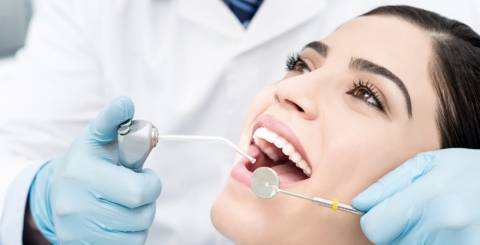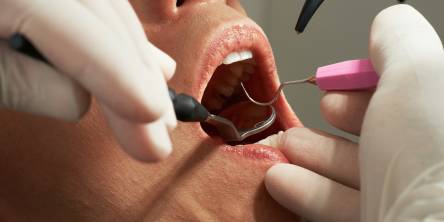9 Symptoms of Gum Diseases and Treatments! Necrotizing Gingivitis

Necrotizing gingivitis is part of a range of disease known as necrotizing periodontal diseases. Necrotizing Ulcerative Gingivitis (NUG) is a severe infection of the gums (gingiva) characterized by gum necrosis, bleeding, and pain. It is diagnosed once specific clinical signs and symptoms begin to develop. It is different from other gum diseases in that it presents with necrosis of gums between teeth ulceration of the papillae, gum bleeding, and pain.
It usually occurs in young adults between the ages of 18-30 years. It is also known as Vincent's Infection, acute ulcer membranous gingivitis, phagedenic gingivitis, fusospirochetal (related to, or caused by Fusobacteria and spirochetes) gingivitis or Trench Disease (due to its outburst in the soldiers during World War 1).
Symptoms
- The rapid or sudden onset of intense pain (localized or generalized).
- Ulcerated and necrotic papillary and marginal gingiva and cratering (punched out) of papillae.
- Intense gingival pain.
- Gums that bleed easily.
- Bad breath.
- Yellowish-white or grayish slough “pseudomembrane” (skin-like tissue) covering ulcerated papilla, swollen or enlarged lymph nodes, fever, and fatigue.
- The Bacterial attack on gum tissues.
- Severe/excruciating pain.
- Lesions or blister-like formations on the gum and gum line.
Risk Factors
- Risk Factors may include the following:
- Psychological anxiety and stress.
- Sleep deprivation.
- Smoking.
- Pre-existing early-stage gum disease (gingivitis) and trauma.
- Inadequate oral hygiene.
- Nutritional Deficiency.
- HIV-positive status.
- Other medical conditions that weaken immunity.
- Immunity-suppressing medication, such as corticosteroids.
- Down’s Syndrome.
- Sudden lifestyle change.
- Males are more at risk than females.
- All the factors mentioned above result in immunosuppression: decreased antibody response, increasing one's vulnerability to the infection.

Diagnosis
- Detailed medical history, including nutrition, lifestyle and health habits.
- Medical consultation and treatment, in case the immunosuppressive disease is suspected.
- Detailed dental account: pain (persistent, intense onset).
- Extraoral examination: for enlarged and swollen lymph nodes of the head and neck.
- Intraoral examination: for clinical features of NUG and the presence of pasty saliva.
- Based on the professional medical check-up, a diagnosis of NUG is established.
Treatment
- Common Initial phase Treatments include:
- Debridement of the infected area which is under local anesthesia.
- Removal of the formed membrane using cotton dipped in chlorhexidine.
- Explain to the patient-specific oral care instructions such as the use of a prescription antibacterial mouthwash: chlorhexidine 0.12% twice daily.
- Manage pain with analgesics: ibuprofen 400-600 mg thrice daily.
- Patient counseling should include education on proper nutrition, oral care, appropriate fluid intake, and quitting of habits such as smoking.
- Antibiotics if patiently is immunocompromised (e.g., AIDS, leukemia,) or in case of development of physical symptoms like fever, malaise, and enlargement or swelling of lymph nodes.
- Follow up with a complete oral examination after the resolution of the condition.
- When the physical manifestation of the disease such as fever is present, antibiotic treatment may be recommended.
- Remaining soft tissue hollows are more vulnerable to further dental attachment loss; these areas may need surgical treatment in the future to avoid complications.
- Sites that don't respond to treatment may occur and may be characterized by recurring and progressive deterioration of the gum and surrounding structural detachment.
- Reasons for unresolved NUG include the failure to remove the irritant, incomplete debridement of infected tissue, inaccurate diagnosis, a patient who doesn't follow treatment protocols and medication, and underlying medical conditions.
- Non-resident patients will need additional therapy, additional medication, and dental consultation. These conditions may tend to recur; therefore, frequent periodontal maintenance visits and thorough oral hygiene are mandatory.
- Your dentist may recommend medicated mouth rinses, brushing with special toothpaste and flossing more frequently to meet your increased need for oral hygiene.
- Untreated, the condition may lead to rapid deterioration of the gum (necrotizing ulcerative periodontitis) and may also spread, as necrotizing stomatitis or noma, into surrounding tissues in the cheeks, lips or the bone structure of the jaw.
- With treatment, even if attachment loss occurs with NUG, resolution post-treatment (regular scaling, root planing, and antimicrobial or rinses), is quick and regeneration of the impacted soft tissues is possible.
Read more: Gingivitis Causes And Treatment

Oral diseases such as acute necrotizing gingivitis flourish easily in people with a compromised immune system. A strong immune system can fight off deadly viral and bacterial infections. Eat a healthy balanced diet with plenty of immunity-boosting nutrients to avoid falling prey to these painful and damaging oral diseases.”
Oral diseases can be easily prevented with professional dental deep cleaning, good oral hygiene, and balanced meals. Regular dental examinations can also help detect gum diseases in early stages. It can be advantageous as early detection can prevent the pain and damage caused by the advancement of the disease. The outcome is always better when medical intervention happens early.
Similar Articles
The desire for a healthy smile drives approximately 4 million people toward teeth straightening procedures. When it comes to straightening teeth, lingual braces offer a discreet alternative to traditional braces and clear aligners.
As we grow older, our dental needs evolve significantly. The carefree days of childhood tooth fairy visits transform into the more complex world of adult dental care. After age 25, many adults begin to notice changes in their oral health.
Missing teeth can cause a wide range of oral health issues. Nonetheless, over 120 million Americans are missing at least one tooth, and the figure is anticipated to climb as time passes.
A dental emergency doesn’t make an appointment. It shows up unannounced and unapologetic, usually in the middle of the night or during a meal that was supposed to be fun
A dental emergency can strike fast and without warning—during dinner, in the middle of the night, or just before a big meeting.
A wide range of factors can have a direct effect on your oral health. A balanced diet is essential, as is good oral hygiene and regular dental examinations. Many individuals think that nutrition alone can't improve oral health.
The results of wearing Invisalign aligners look stunning, and they are way more convenient than traditional braces. However, no one speaks about what it feels like to wear the same pair of traces around 22 hours a day
Temporomandibular Joint Disorder, commonly known as TMJ, is a condition that causes pain and dysfunction in the jaw joint and surrounding muscles. This disorder can arise from various factors, including teeth grinding, arthritis, jaw injuries, poor posture, or stress.
A root canal is a common treatment that people pay the dentist a visit for. According to a study, root canal treatment claims were up by 42% in the last five years.









